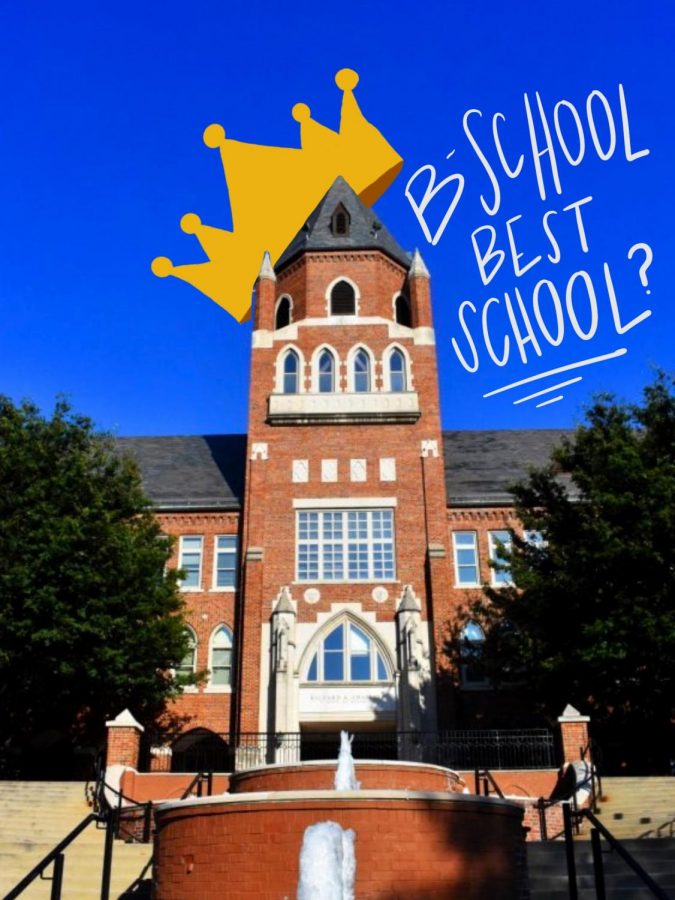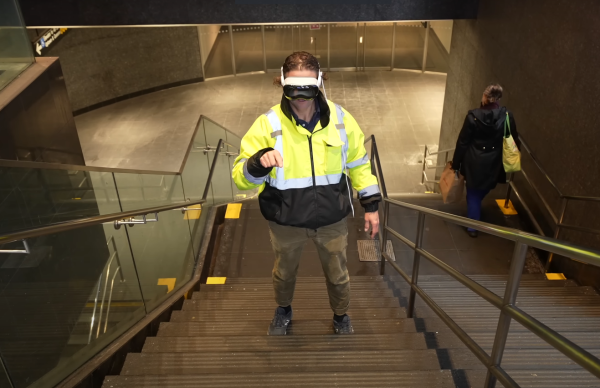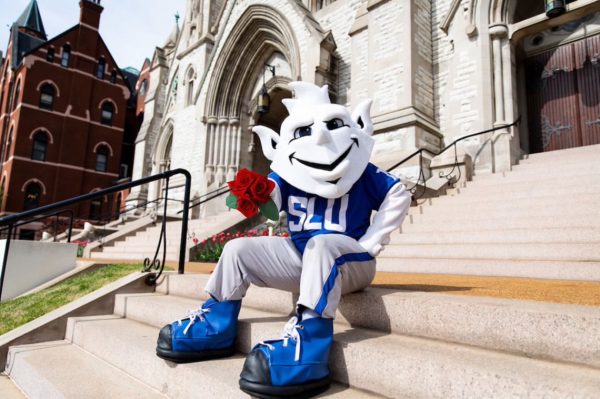Non B-School Majors Beware; SLU Doesn’t Care
The Chaifetz School of Business of Saint Louis University stands as a monument to capitalism, free trade and profit. In terms of sheer size, Cook and Davis-Shaughnessy Halls dominate campus around the clock tower. Comparatively, the buildings that make up the College of Arts and Sciences are a bit small.
This difference didn’t really bother me for the first few years I attended SLU. I chalked up the B-School’s fanciness to the fact that an entire college was housed in one building. Over time, however, I’ve become a bit bothered by some of the stark differences between the College of Arts and Sciences and the Business School.
While the College of Arts and Sciences offers over 35 majors to undergraduates, the Business school only has 11 options for undergraduates to choose from. Despite this wide disparity in the number of programs offered, business students seemingly have more resources at their disposal to succeed after graduation.
While every undergraduate has access to SLU’s Career Services office based in Griesedieck Hall, business students have exclusive access to the Valerie A. Davisson Career Resources Center. Here, students are able to access excellent career opportunities with companies such as Boeing and McDonnell Douglas.
Meanwhile, the best career advice students receive from SLU’s Career Services is a crash course on how to use Handshake, a website which is assuredly simple and almost exactly like LinkedIn. Keep in mind that SLU also just spent millions of dollars to move Career Services to their new location. And for what? The last time I made an appointment for career advice, I was given a flyer on how to make a good resume and essentially left to my own devices.
Business students also have access to the “Centers of Distinction” located in the business school. These include the Center for Entrepreneurship, the Emerson Leadership Institute, the Center for Supply Chain Excellence and the Boeing Institute of International Business. While there are certainly many clubs and organizations available for other students to engage in, these clubs don’t receive the kind of funding and opportunities that these “Centers of Distinction” do.
Program differences aside, the Business School itself is just cooler. Students are immediately greeted by an electronic building directory as soon as they enter, office chairs are used in every classroom and it has a beautiful atrium for students to hang out and chat with one another. There are, however, more questionable aspects that separate the business school from other areas on campus.
If you’ve ever been in a classroom in the Business School, chances are that you’ve noticed the extra lock near the bottom of each door. The point of these locks is so that anyone can duck below the grated window and secure the door in the event that a “violent intruder” enters the building. That’s right: business students have access to an extra layer of safety in an active shooter scenario. As far as I know, no other building on campus has these locks.
On top of that, signs advising students on what to do in case of an intruder are hung up around the entire building. Not only are business students afforded an extra layer of security just for choosing their particular area of study, but they’re also provided extra instructions on what to do in the event of an active shooter on campus.
The College of Arts and Sciences is by no means small: according to SLU’s website, there are currently 2,301 students in the college. In 2012, the Chaifetz School of Business had a total enrollment of around 1,900 students. So, despite each college having a similarly sized enrollment, large discrepancies in access to resources remain. So, the question remains: why do these stark differences exist?
Money. The business school was recently renamed in honor of SLU alumnus Richard Chaifetz, who gave $15 million to exclusively benefit the college. In 2018, Rex and Jeanne Sinquefeld gave $50 million to SLU, a large portion of which went to creating the Sinquefield Center for Applied Economic Research in the business school.
Like any institution of higher learning, SLU has to make money in order to survive and grow. It relies on donations from its alumni to expand and improve its academic programs. The danger in allowing donors to choose what to invest in, however, is that it will inevitably result in a disparity in the quality of education students receive.
It is no secret that SLU has recently sought to shrink its liberal arts offerings. Meanwhile, STEM and business programs continue to improve and expand. As society fills with more doctors and corporatists, what will happen to the writers? The artists? The journalists? The politicians? The historians? What will happen when we, as a culture, value making money more than seeking truth and bettering ourselves?
As a Jesuit university, SLU advertises educating the whole person. Yet, the administration guts the very programs it says it holds so near and dear to its heart. It flaunts “Jesuit values” while tokenizing Black and Brown students. It builds obnoxious service clocks to advertise its “commitment to the community.” In reality, SLU only cares about making money. That’s all there is to it.
As a result, my education and the education of thousands of other students is brushed aside and tarnished. As a political science major, my dream is to make a positive impact on the lives of as many people as possible. I don’t seek to make vast amounts of money. Chances are that I won’t be able to donate a lump sum of $50 million back to SLU someday. Because of that, the administration refuses to invest in my future in the same way that they would for a business student.
The hypocrisy at the core of the SLU administration is evident. Dr. Pestello and his colleagues in the administration say one thing but mean another, and ultimately only reward those who see the world in the same way that they do. As we seek to hold the university accountable to its mission of social justice, we must be diligent in calling out injustice when we see it. We must call for transparency into our schools finances. We must demand that our school upholds the ideals it sanctimoniously flaunts. Together, we can change SLU for the better.
Your donation will support the student journalists of Saint Louis University. Your contribution will help us cover our annual website hosting costs.












student • Feb 17, 2021 at 12:07 am
You sound pretty butthurt, dude. This is not cute
Business major • Nov 15, 2020 at 2:17 pm
I want to set aside all of your article except the bit about the b school career resources and address that specifically. I’m not sure who you talked to or how you got this idea that the bschool students have incredible career resources (aside from the sole fact the bschool has its own resources) because I have repeatedly attempted to use the bschool career resources for their “expertise” and I have been disappointed every time. I get talked down to, given conflicting information, and I have learned they are absolutely USELESS when you are looking for any help for careers outside of Stl. To top it off, even the director of the department has no industry-specific knowledge. As a marketing major, none of them can give me any specialized advice for how to prepare myself for a career in marketing. The just refer me to professors.
To sum it up, the bschool career resources are worthless to anyone besides freshmen. It’s clear lots of bold assumptions were made when writing this article- both about the career resources and other aspects of the bschool.
That’s not to say bschool students don’t see its flaws- we most certainly do. Did you know students and SLU professors aren’t even allowed to use Chaifetz’s new econ investment.
business major • Oct 12, 2020 at 9:16 am
1. I’m sorry your experience at Career Services was subpar, but I think you water down the work that they do. “The best career advice students receive from SLU’s Career Services is a crash course on how to use Handshake.” I disagree: they offer resume reviews, mock interviews, networking advice, LinkedIn visibility advice, circulate job postings, organize career fairs, and more. I personally have gotten my resume completely revamped with the help of career services as well as gotten a job offer as the direct result of a Career Services event.
2. The business school does have its own career center. However, that is because our internship and job search process is much more involved and rigorous than what it might look like from the outside. Prestigious internships are secured in early fall, beginning as early as after freshman year. Additionally, networking is a huge, huge element to job searching in the business world. The business career center works closely with students to enhance networking skills, which often requires more time and refinement than a simple career services visit, so more staff and resources are needed.
3. Yes, the Centers of Distinction are unique to the business school and certainly a little odd. I’d point out that they are typically sponsored by corporate partners (i.e, The Boeing Institute for International Business and the Emerson Leadership Institute), so that money isn’t coming from elsewhere in SLU’s budget. Additionally, the Centers of Distinction typically represent very dynamic fields that require an almost constant updating of curriculum, so more resources as well as outside perspectives to keep them relevant. These Centers also serve our MBA students.
4. The business school is indeed “cooler,” no question, it’s obviously a very nice building. However, I’d like to add that the business school regularly serves as an event space for SLU-wide events, including those for prospective students and families, speakers, and fundraisers. Numerous business school classrooms are used for non-business disciplines, as well- I myself have had a philosophy, theology, and English class there. Additionally, the atrium and study spaces are open to all students, too- not just business students. You’re welcome to use those any time- they’re not an exclusive club. Also, I’m not sure what you mean by “office chairs.” The business school has swivel chairs that are the same as the chairs in buildings like Morrissey and Pius.
5. Regarding the business school’s enhanced safety measures- I can see how without background, that seems totally unfair. However, what happened is that one of the members of the board of the business school is passionate about gun violence prevention and attended seminars on how to keep students safe in an active shooter situation. As a result, they personally funded the addition of the locks added to business school doors. They also created the Chaifetz Safety Committee, who created the “instruction” cards that you mentioned (though they are very short, all they say is run, hide, and fight). I’m sure that that committee member does not value business students’ lives inherently more than others — but they only have control over the business school.
6. Regarding donations to the business school, I’d like to again discuss the resources it requires to remain up and running (career center, maintenance of the building, etc) but also, let’s not forget that the business disciplines are ever-changing with technology and modernization. Every year, the business school has to update the software licenses and databases which business students need to learn in order to succeed. Those cost immense amounts of money, but we need them in order to stay functional. Of course, lots of disciplines require expensive technology, there’s no denying it. But ours change literally every year, racking up a huge expense.
7. You assume that business majors must “value making money more than seeking truth and bettering ourselves.” Other SLU students tend to assume that business majors are just cogs in a cruel corporate machine who wake up every day and think “money, spreadsheets, profits, taking advantage of others.” I’m sorry if you’ve experienced a business major with that attitude. But what you miss out on is the vast majority of business majors who care about being good people and bettering ourselves and others. Every day, we look for ways to use our abilities to meaningfully contribute to society. Many of us strive to work hand-in-hand with the brilliant, awe-inspiring writers, politicians, and historians you talk about. We want to work for inclusive, meaningful, mission-driven employers. We want to bolster the economies of our communities, create job opportunities, and improve others’ quality of life. Maybe I can’t express myself like an English major, or have the savvy of a political science major, but I’m good at analyzing data and managing finances. That doesn’t mean my skills are less valuable- just that I can contribute to society differently. While Arts and Sciences graduates undertake meaningful work, my classmates and I will be there behind them, ready to run the numbers and allocate their resources effectively. We’ll be ethical, impactful leaders of corporations and genuinely work to better our employees’ lives. We’ll work to make sure that food flows through the supply chain and make it to the grocery store and onto your kitchen table. We’ll boost the marketing of a nonprofit and help them succeed in their mission. We have goals that go beyond the bottom line of a financial statement.
I’m sorry this comment was long, but I take a lot of jabs for my chosen major, so this hit a bit of a nerve for me. I feel like every time I hang out with my friends, I get told that I’m exploiting the working class, or destroying the planet, or that I only care about money. Believe me, I know people like that exist in the business world. But as graduates from SLU, we will work to be the next generation of business leaders and change that problematic mode of operation. We’re really, really trying. Maybe we can’t write the next great American novel or run for public office, but we have other skills that we will use to better the world in our own way.
nope • Oct 7, 2020 at 11:48 pm
Let’s talk.
1. Your depiction of SLU’s Career Services is bleak and frankly a little insulting to the diligent employees who work there. I’m sorry your experience was subpar, but you immensely water down the work that they do. “The best career advice students receive from SLU’s Career Services is a crash course on how to use Handshake.” Really? You clearly haven’t been to Career Services very much. They offer resume reviews, mock interviews, networking advice, LinkedIn visibility advice, circulate job postings, organize career fairs, and more. I personally have gotten my resume completely revamped with the help of career services as well as gotten a job offer as the direct result of a Career Services event… So, not nothing.
2. The business school does have its own career center. However, that is because our internship and job search process is much more involved and rigorous than what it might look like from the outside. Prestigious internships are secured in early fall, beginning as early as after freshman year. Additionally, networking is a huge, huge element to job searching in the business world. The business career center works closely with students to enhance networking skills, which often requires more time and refinement than a simple career services visit, so more staff and resources are needed.
3. Yes, the Centers of Distinction are unique to the business school and certainly a little odd. I’d point out that they are typically sponsored by corporate partners (i.e, The Boeing Institute for International Business and the Emerson Leadership Institute), so that money isn’t coming from elsewhere in SLU’s budget. Additionally, the Centers of Distinction typically represent very dynamic fields that require an almost constant updating of curriculum, so more resources as well as outside perspectives to keep them relevant. These Centers also serve our MBA students.
4. Yep, the business school is “cooler.” I’m not gonna fight you on that, it’s obviously a very nice building. However, I’d like to add that the business school regularly serves as an event space for SLU-wide events, including those for prospective students and families, speakers, and fundraisers. Numerous business school classrooms are used for non-business disciplines, as well- I myself have had a philosophy, theology, and English class there. The atrium and study spaces are open to all students, too- not just business students. They’re not an exclusive club. Also, what are “office chairs?” Do you mean swivel chairs? They’re the same as the chairs in buildings like Morrissey and Pius. We’re not sitting in fancy leather chairs all day.
5. Regarding the business school’s enhanced safety measures- I can see how without background, that seems totally unfair. However, what happened is that one of the members of the board of the business school is passionate about gun violence prevention and attended seminars on how to keep students safe in an active shooter situation. As a result, they personally funded the addition of the locks added to business school doors. They also created the Chaifetz Safety Committee, who created the “instruction” cards that you mentioned (though they are very short, all they say is run, hide, and fight, but okay, sure). I’m sure that that committee member does not value business students’ lives inherently more than others — but they only have control over the business school.
6. Regarding donations to the business school, I’d like to again discuss the resources it requires to remain up and running (career center, maintenance of the “cooler” building, etc) but also, let’s not forget that the business disciplines are ever-changing with technology and modernization. Every year, the business school has to update the software licenses and databases which business students need to learn in order to succeed. Those cost immense amounts of money, but we need them in order to stay functional. Of course, lots of disciplines require expensive technology, there’s no denying it. But ours change literally every year, racking up a huge expense.
7. You assume that business majors must “value making money more than seeking truth and bettering ourselves.” Nice. You, and many others, assume that business majors are just cogs in a cruel corporate machine who wake up every day and think “money, spreadsheets, profits, taking advantage of others.” I’m sorry if you’ve experienced a business major with that attitude. But what you miss out on is the vast majority of business majors who (surprise!) care about being good people and bettering ourselves and others. But every day, we look for ways to use our abilities to meaningfully contribute to society. Many of us strive to work hand-in-hand with the brilliant, awe-inspiring writers, politicians, and historians you talk about. We want to work for inclusive, meaningful, mission-driven employers. We want to bolster the economies of our communities, create job opportunities, and improve others’ quality of life. Maybe I can’t express myself like an English major, or have the savvy of a political science major, but I’m good at analyzing data and managing finances. That doesn’t mean my skills are less valuable- just that I can contribute to society differently. While Arts and Sciences graduates undertake meaningful work, my classmates and I will be there behind them, ready to run the numbers and allocate their resources effectively. We’ll be ethical, impactful leaders of corporations and genuinely work to better our employees’ lives. We’ll work to make sure that food flows through the supply chain and make it to the grocery store and onto your kitchen table. We’ll boost the marketing of a nonprofit and help them succeed in their mission. We have goals that go beyond the bottom line of a financial statement, believe it or not.
I take a lot of jabs for my chosen major. I feel like every time I hang out with my friends, I get told that I’m exploiting the working class, or destroying the planet, or that I only care about money. Believe me, I know people like that exist in the business world. But as graduates from SLU, we will work to be the next generation of business leaders and change that problematic mode of operation. But please, give us some credit. We’re trying. Maybe we can’t write the next great American novel or run for public office, but we have other skills that we will use to better the world in our own way.
SLU Grad • Oct 5, 2020 at 9:18 pm
McDonnell Douglas hasn’t been an entity since they merged with Boeing in 1997. Lazy research and reporting there.
What’s keeping you from learning how commerce and entrepreneurship can empower people and communities to do good and drive economic equity? Why not take some courses over there on Lindell and learn about sustainability, diversity, inclusion, and mission driven enterprise? Get a minor or a certificate and then you can sit in the building and use the resources there.
Regarding the writers, artists, journalists, politicians, and historians of whom you speak…check the job postings out there across the country. Accountants, financiers, managers, and marketers work hand in hand with these people every day to create new products and services and to tell stories and to build better communities.
You may also want to check the background of Dr. Chaifetz…he’s an A&S grad.
Peace
Dixon Cider • Oct 5, 2020 at 1:17 pm
Great article except you sound insane and SLU just made a new STEM building so your entire argument doesn’t make sense.